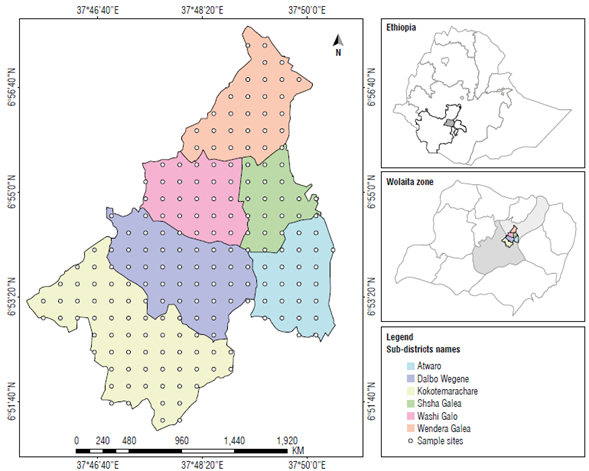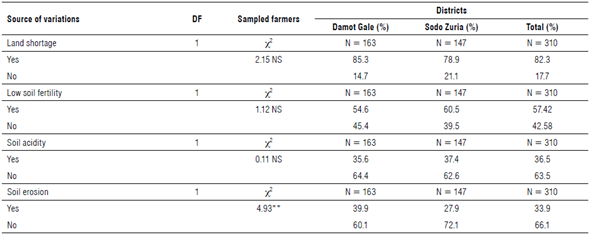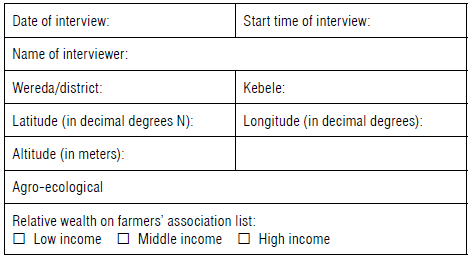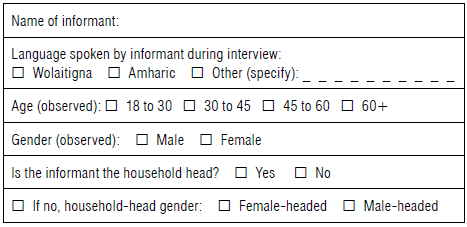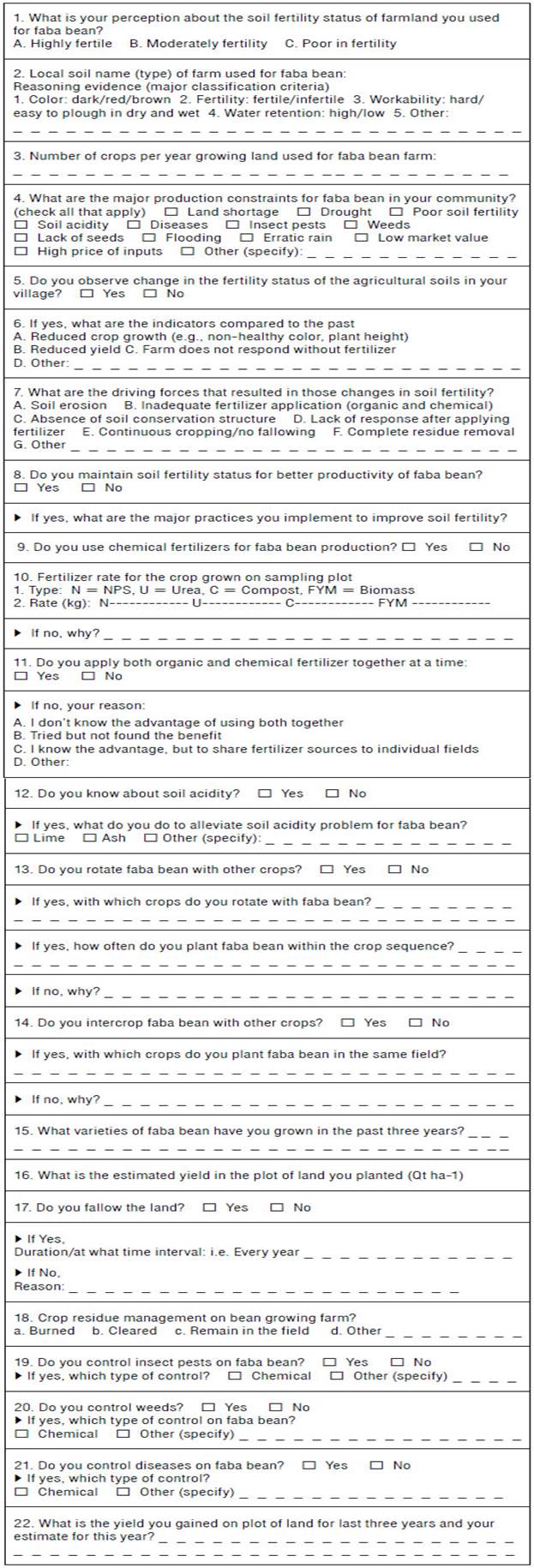Introduction
Faba bean (Vicia faba L.) is one of the major pulse crops grown in the highlands of Ethiopia (Fedaku et al., 2019). Currently, it occupies 31% of the area cultivated to pulses (1,863,445 ha) in the country (CSA, 2019). The crop plays significant roles in human and livestock feed and the improvement of soil fertility (Mulugeta et al., 2019). However, the productivity of the crop in the country is low (2.12 t ha-1) compared to the average yield (3.7 t ha 1) obtained in major faba bean producing countries in the world (FAOSTAT, 2017; CSA, 2019). In Wolaita zone, faba bean occupies 96.4% of the area of land cultivated to pulses (1,074.91 ha) (CSA, 2019), while the farmers harvest a lower average yield (1.2 t ha-1) than the national average yield obtained in the country (CSA, 2018). The major factors usually mentioned for the low yield of faba bean in Wolaita zone include climatic conditions, edaphic factors (soil fertility and acidity), biotic factors (diseases, pests, and weeds), scarcity of improved varieties, and poor agronomic practices (Buraka et al., 2016).
Extensive exploitation and depletion of nutrients occur in Ethiopia due to continuous cropping, limited fallowing and crop rotation, complete removal of crop residues, and minimum or no use of mineral fertilizers and lime on acidic soil (Haileslassie et al., 2006; Abera & Belachew, 2011). The loss of nitrates, phosphates, and potassium in the soils results in macronutrient imbalance (Ayalew & Dejene, 2011; Shanka et al., 2018). Kassa Colbe et al. (2020) indicate that the soil management intervention of Wolaita zone farmers is also inadequate to improve soil fertility and produce high yield. The cumulative effect of nutrient deficiency in the soils has resulted in less productivity of faba bean in Wolaita zone (Buraka et al., 2016; Belete et al., 2019).
Several researchers studied soil fertility management practices for faba bean production in different parts of Ethiopia (Agegnehu & Yirga, 2009; Fedaku et al., 2019; Mesfin et al., 2020). Those reports revealed that significant improvements in the yield of faba bean can be brought about by proper soil fertility management like crop rotation, crop residue management, fallowing, application of balanced fertilizer, and use of lime on acidic soils. However, in Wolaita zone, limited research is done on the soil fertility management practices of faba bean producing farmers, and little information is available. Concrete information is required about farmer soil fertility management for faba bean production to rate the potential and limitations of the soils for faba bean productivity in the farming area of Wolaita zone. In the meantime, the findings enable the formulation of strategies for soil fertility management and forward directions to enhance the crop production of smallholder farmers. Therefore, this study aimed to investigate the effects of farmer soil fertility management on faba bean productivity.
Materials and methods
Study area
The study was conducted in Damot Gale and Sodo Zuria woredas (districts), Wolaita zone, in Southern Ethiopia (Fig. 1) during the 2019 growing season. The districts were selected based on their high faba bean production potential. Ethiopia is located from 3°00'00" to 14°08'00" N, and 33°00'00" to 48°00'00" E in Eastern Africa. Damot Gale district is located from 6°55'22" to 7°05'00" N and 37°45'31" to 37°59'58" E. The elevation of Damot Gale district ranges from 1501 to 2950 m a.s.l. (Mota et al., 2019). Sodo Zuria district is located from 6°46'60" to 6°56'45" N and 37°38'10" to 37°50'60" E at an elevation from 1500 to 3500 m a.s.l. (Bashe et al., 2018). According to MOA (1998) classification, faba bean producing areas of both Damot Gale and Sodo Zuria districts are predominantly characterized by cool sub-humid climates (Woinadega). The total annual rainfall of Damot Gale district in the last ten years (2011-2020) was 1,181 mm and that of Sodo Zuria district was 1,426 mm. Both districts have a bimodal rainfall pattern, which consists of Belg (short rainy season) and Meher (long main rainy season) (FAO, 2020). The Belg rainfall in the Zone occurs mainly during March, April, and May and the Meher rain occurs during June, July, and August. In Damot Gale district, about 32.9% and 38.2% of the precipitation occurred during the Belg and Meher, respectively. The last ten-year mean monthly temperature of Damot Gale district ranged from 13.8 to 24.9°C with an average of 19.4°C. In Sodo Zuria district, about 31% and 40% of precipitation occurred during the Belg and Meher, respectively. The mean monthly temperature of Damot Gale district in the last ten years ranged from 15.4 to 25.8°C with an average of 20.6°C. The agricultural practices are predominantly small-scale mixed subsistence farming. The cropping system is mainly based on continuous cultivation without any fallow periods (Laekemariam et al., 2016). The colors on the map indicate six sub-districts of the study.
Sampling method and sample size
The sample size for each district was fixed according to Yamane's (1967) simplified formula to calculate the sample size:
where n is the sample size, N is the population size, and e is the level of precision at 95% confidence level. The number of samples varied in the sub-districts depending on the number of the human population residing in the areas. Hence, 310 household heads (163 from Damot Gale and 147 from Sodo Zuria) were interviewed about the soil management practices for faba bean production.
Data collection
The short-structured questionnaire (Supplementary material 1) used to record the soil fertility management practices included cropping history, crop rotation practices, fallowing, cropping intensity, production constraints, soil fertility management practices, crop residue management, seed use (local seed purchased from the local market and improved seed obtained freely from a research center), and fertilizer use (types and rates). The altitude and latitude of each farm was recorded by using the global positioning system (GPS).
Statistical analysis
To analyze the data, descriptive statistics were employed. Mean and percentage were computed for different variables. Pearson chi-square, t, and F tests also were calculated. Data analysis was carried out using the statistical package for social sciences (SPSS) software version 20 (SPSS, 2011).
Results and discussion
Faba bean farmer soil classification
In the study area, the faba bean producing farmers classified and assigned the local names to the soils to manage these accordingly. Farmers in both Damot Gale and Sodo Zuria districts used similar parameters to classify and name the soils. These farmers characterized and named seven faba bean growing soil types by using bita as a suffix, which connotes the term "soil" in the Wolaitia language. According to this, the soils were Arradabita (Eutric Nitosols), Lada bita (Haplic Alfisols), Kareta bita (Humic Nitisols), Zo'o bita (Vertisols), Gobo bita (Vertisols), Chare bita (Orthic Luvisols), and Talla bita (Haplic Alisols) (Fig. 2). The first six soils are common in both districts, except for Talla bita, which is found in Damot Gale district only. Among the soil types, Arrada bita is predominant in both districts, followed by Lada bita. Zoo bita is less represented in both districts (Fig. 2).
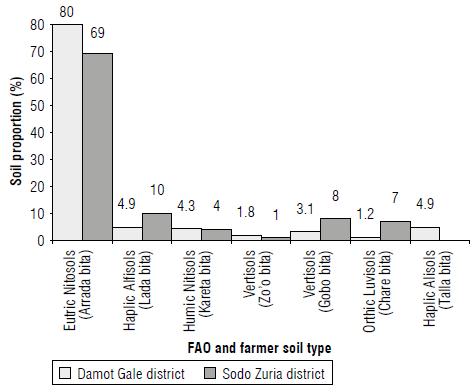
FIGURE 2 FAO and farmer soil types for samples collected from Damot Gale and Sodo Zuria districts in Wolaita zone, Southern Ethiopia.
Most farmers used soil color, soil fertility, workability, and water permeability as the criteria for classification (Tab. 1). Accordingly, farmers considered black/dark soil as fertile and suitable for faba bean productivity, while the brown/red soil is considered of low fertility and less productive. The perception of farmers was also reported by Bobo et al. (2017) and Corbeels et al. (2000) who stated that the dark soil is more fertile than brown. In general, farmers ranked Arrada bita in the highest to medium fertility status. Similarly, most faba bean farmers preferred Arrada bita for enhanced productivity.
TABLE 1 Classification and commonly perceived soil characteristics by faba bean farmers at Damot Gale and Sodo Zuria districts in Wolaita zone, Southern Ethiopia.

"Bita" means soil In Wolaita language.
On the contrary, Lada, Gobo, Zo'o and Chere bita were ranked as of low fertility and were the less preferred soils for faba bean production. The farmers ranked Talla and Kareta bita under medium to low soil fertility class (Tab. 1). Overall, as noticed from the interview, the majority of the farmers planted faba bean in fertile soil (Arrada bita).
Cropping history of faba bean farms
Crop intensity
The number of crops grown each year on a faba bean production field varies from one to three, depending on the soil fertility and amount of rainfall in the cropping season. The cropping intensity varied significantly among districts (X2 = 22.93, P≤0.001) (Tab. 2). Also, the intensity was in the order of two crops>one crop>three crops per land per year (Tab. 1). About 54% and 63.3% of the interviewed farmers have grown two successive crops a year in the same field at Damot Gale and Sodo Zuria districts, respectively. On the other hand, 42.3% and 22.5% of the sampled farmers have grown only one crop per year on a plot of land at Damot Gale and Sodo Zuria districts, respectively. However, very few Damot Gale (3.7%) and Sodo Zuria district (14.2%) farmers had grown three successive crops a year in the same field (Tab. 2). The majority (58.4%) of the interviewed farmers had grown more than one crop each year (Tab. 2).
TABLE 2 Faba bean farmer cropping practices in the sampled agricultural fields at Damot Gale and Sodo Zuria districts of Wolaita zone, Southern Ethiopia.

X2 - Chi-square value; N - number of sampled farmers involved in faba bean cropping practices; ***Significant at P<0.001; NS - not significant; DF - degree of freedom.
The sampled smallholder farmers indicated poor soil fertility, inorganic fertilizer prices and a limited labor force as challenges to grow more than one crop each year on a field. Hence, most of the study area farmers were economically poor, leading a hand to mouth lifestyle. Similarly, soil fertility constraints, limited rainfall, and financial problems were reported in different parts of Ethiopia (Headey et al., 2014; Kemaw & Fentahun, 2018). In general, cultivating only faba bean per plot each year would reduce over-exploitation of soil nutrients and would increase grain production. Nevertheless, multiple cropping had a relative yield and economic advantage to single cropping. Increased cropping intensity requires better soil fertility management (Kemaw & Fentahun, 2018). In this regard, the sampled faba bean fields were not managed adequately. Therefore, increased cropping intensity results in large nutrient exploitation, unless proper soil management practices are applied to balance required nutrients.
Faba bean varieties used in studied districts
The number of farmers who grow improved varieties did not show statistical differences between both districts (Tab. 2). The local faba bean variety was dominant over-improved varieties and covered about 65.6% and 64% at DamotGale and Sodo Zuria districts, respectively (Tab. 2). Different research studies conducted on acidic soils in Ethiopia showed that the improved varieties had a significantly higher grain yield over the local variety (Agegnehu & Yirga, 2009; Belachew & Stoddard, 2017). However, the results in this study indicated that very few farmers grow improved varieties (Tab. 2). As noticed from the discussion, farmers used only 'Dosha' as the improved faba bean variety. Thus, the predominant growth of the local variety might be among the reasons for far lower productivity in the studied districts.
Faba bean production constraints
Land shortage
The number of faba bean farmers challenged by land shortage did not significantly vary between Damot Gale and Sodo Zuria districts (Tab. 3). The survey recognized that most of the farmers have less than a "Timad'' or 0.25 ha of land per household. In line with the findings of this study, the Wolaita Zone Administration (2019) indicated that 60% of households in Wolaita zone possessed less than 0.25 ha of farmland, which is smaller than the national average of 1.01 ha (Milas & Aynaoui, 2004). Overall, 85.3% and 78.9% of farmers interviewed in Damot Gale and Sodo Zuria districts, respectively, indicated farm size as a constraint for faba bean production (Tab. 3). Consequently, the abandonment of fallowing in the studied districts was recorded, which resulted in low soil fertility and faba bean productivity. Different studies conducted in Ethiopia also indicated small farmland size as a reason for continuous cultivation and less crop productivity (Headey et al., 2014; Kemaw & Fentahun, 2018). In general, continuous cultivation without fallowing due to small farm size affected the soil fertility and faba bean productivity in the studied districts. Hence, maintenance of the soil fertility status through fertilizer application and the use of different soil management interventions are required to restore the soil and faba bean productivity.
Poor soil fertility
Farmers used the soil color, workability, water permeability, and water holding capacity as criteria to judge the soil fertility status. Bobo et al. (2017) and Corbeels et al. (2000) also reported similar perceptions of farmers to classify the soil fertility status. Thus, the dark soil, which has high water retention and is easy to plow, is classified as fertile by faba bean growers in both districts. Accordingly, the farmer perception about the soil fertility status did not significantly vary between Damot Gale and Sodo Zuria districts (Tab. 3).
About 54.6% and 60.5% of the interviewed farmers at Damot Gale and Sodo Zuria districts complained about the poor soil fertility as one of the faba bean production constraints (Tab. 3). In line with the findings of this study, Buraka et al. (2016) indicated poor soil fertility as one of the faba bean production constraints in Wolaita zone. Though poor soil fertility constrains faba bean growers, farmers have limited capacity to improve the soil fertility by applying adequate mineral fertilizer, liming and managing residues. Thus, soil fertility interventions require special attention.
Soil acidity
The short-structured questionnaire was used to verify whether soil acidity is a constraint for faba bean production in the studied districts. Most of the interviewed farmers did not know what soil acidity means. However, those few who indicated soil acidity as a constraint used the wilting of leaves, stunted growth, and inadequate fertilizer application conditions as the criteria to judge. The chi-square statistic revealed a non-significant difference between Damot Gale and Sodo Zuria districts in the number of farmers who perceive soil acidity as a constraint (Tab. 3). About 35.6% of Damot Gale and 37.4% of Sodo Zuria district farmers complained about soil acidity as a constraint for faba bean production (Tab. 3). Buraka et al. (2016) also reported soil acidity as a serious constraint for faba bean production in Wolaita zone. Hence, soil acidity is a problem for optimal faba bean productivity, even with fertilized soil. Therefore, identifying the proper lime rate and timely application is required to reduce the soil fertility problems and to improve faba bean productivity.
Soil erosion
The number of farmers who complained about soil erosion as a constraint for faba bean production showed significant variation (X2 = 4.93, P≤0.01) between both districts (Tab. 3). Out of the interviewed farmers, 39.9% and 27.9% indicated soil erosion as a production constraint at Damot Gale and Sodo Zuria districts, respectively (Tab. 3). This implied that soil erosion is among the major constraints for faba bean production.
The erosion problem is more serious at Damot Gale than at Sodo Zuria. The higher erosion in Damot Gale district may be due to steeper slopes than in Sodo Zuria district (Laekemariam, 2015). In general, intensive crop cultivation, complete crop residue removal, and high nutrient depletion may intensify erosion in the soils under faba bean cultivation (Buraka et al., 2016).
Soil fertility management practices for faba bean production
Mineral fertilizer application
The mineral fertilizer application practice significantly varied between districts (X2 = 0.50, P≤0.05) (Tab. 4). Only 29.5% and 25.9% of the sampled farmers applied mineral fertilizer in Damot Gale and Sodo Zuria districts, respectively (Tab. 4).
TABLE 4 Faba bean farmer soil management practices in the sampled agricultural fields at Damot Gale and Sodo Zuria districts of Wolaita zone, Southern Ethiopia.
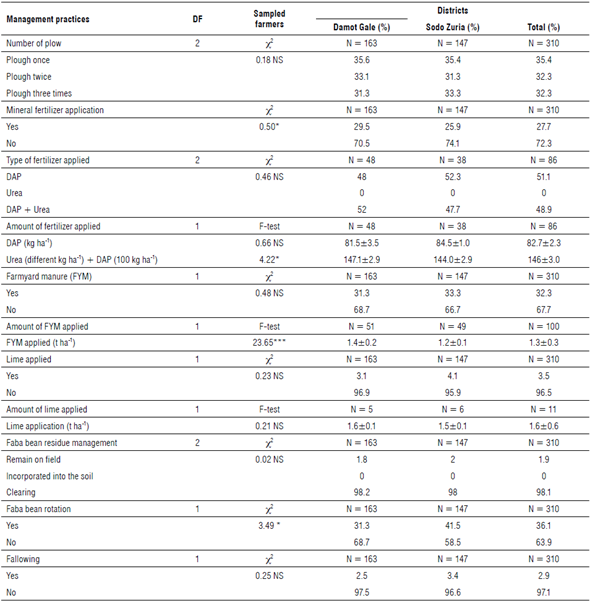
N represents the number of farmers involved in cropping practices; *, *** significant at P≤0.05, 0.001, respectively; NS - non-significant difference; DAP- diammonium phosphate; FYM -farmyard manure; DF - degree of freedom.
The farmers mentioned limited financial capacity and increasing price of mineral fertilizer as the reasons for limited fertilizer application. Other researchers also mentioned these factors as a challenge for applying adequate amounts of fertilizers (Abebe & Abebe, 2016; Guteta & Abegaz, 2016). A significant number of farmers are skeptical of the application of mineral fertilizers. Those farmers believed that a crop does not require inorganic fertilizer. However, the previous study in the neighboring district of Boloso Sore, Wolaita zone by Buraka et al. (2016) indicated a significant yield improvement in faba beans when fertilizers were applied. Farmer perception of fertilizer use should be corrected to improve faba bean yield. Identifying the type of fertilizer and defining the best rate is required for optimum economic return of the faba bean.
Type of fertilizer applied
The type of inorganic fertilizers used among farmers did not show statistical differences between both districts. The mineral fertilizer applied by farmers was either diammonium phosphate (DAP) alone and/or DAP and urea together at a different time (Tab. 4). Farmers in both districts did not apply urea fertilizers alone for faba bean production.
Overall, about 48% and 52.3% of the sampled faba bean fields were managed with DAP fertilizer alone at Damot Gale and Sodo Zuria districts, respectively. The remaining 52% (Damot Gale) and 47.7% (Sodo Zuria) sampled fields were managed with DAP and urea fertilizers together (Tab. 4). Those farmers who used urea and DAP in combination applied DAP at the time of sowing and urea at the active vegetative stage.
Amount of fertilizer applied
The amount of combined application of urea and DAP fertilizer significantly varied (4.22, P<0.05) between districts (Tab. 4). The sampled farmers applied 100 kg ha-1 DAP and 50 kg ha-1 urea at planting and active vegetative stage, respectively. This rate is in line with EIAR (2018) blanket recommendations of 100 kg ha-1 DAP and 50 kg ha-1 for all legume crops. However, due to the differences in inherent soil properties and spatial variation, the blanket management approach could not address yield-limiting nutrients in the soils to enhance faba bean productivity. Thus, adequate site-specific fertilizer recommendation is required for improved crop productivity (Mulugeta et al., 2019).
The rate of combined application of urea and DAP was significantly higher in the Damot Gale (147.1±2.9) than in Sodo Zuria district (144.0±2.9) (Tab. 4). Laekemariam et al. (2016) also reported that more urea and DAP were applied for crop production in Damot Gale than in Sodo Zuria district. Generally, the use of low amounts and non-balanced nutrients leads to nutrient depletion and reduced faba bean productivity.
Farmyard manure application
The use of cow farmyard manure (FYM) for faba bean did not show significant variation between both districts (Tab. 4). Only 31.3% of Damot Gale and 33.3% of Sodo Zuria district farmers applied farmyard manure for faba bean production (Tab. 4).
Most farmers who applied FYM did so near to their residence rather than to distant faba bean plots. Additionally, growers indicated the farm distance from their residence and a shortage of manure as the major reasons for lower manure application. Corbeels et al. (2000) also reported for the Tigray regional state in Northern Ethiopia higher FYM rate near residence than on distant plots due to the difficulty in transportation. However, the application of an adequate amount of FYM for faba bean is of substantial importance to improve the productivity of small-scale farmers (Fedaku et al., 2019).
Farmyard manure application rate
The FYM applied rate for faba bean indicated significant (23.65***) variations among the studied districts (Tab. 4). The FYM application rate was significantly greater in Da-mot Gale than in Sodo Zuria district (Tab. 4).
The amount of FYM applied both in Damot Gale and Sodo Zuria ranges from 1 to 2 t ha-1. Among FYM applying farmers, 59.2% and 81.6% applied 1 t ha-1 in Damot Gale and Sodo Zuria districts, respectively, and the remaining farmers applied 2 t ha-1. The average application rate for faba bean varies between 1.4±0.2 t ha-1 and 1.2±0.1 t ha-1 in Damot Gale and Sodo Zuria districts, respectively (Tab. 4). Buraka et al. (2016), in a study in the neighboring district of Boloso Sore in Wolaita zone, revealed that faba bean required 4 t ha-1 for optimum growth. Yield improvement of faba bean was reported in different parts of Ethiopia due to FYM application, in which pH, available P, and cation exchange capacity of the soil increased (Agegnehu & Yirga, 2009; Fedaku et al., 2019). Thus, the FYM rate used in the studied districts is very low and negatively affects the soil fertility status, requiring replenishment of nutrients.
Lime application
Faba bean farmers who applied lime in the study used CaCO3 as the liming material. Lime application had no significant statistical differences between both districts (Tab. 4). About 3.1% and 4.1% of the farmers applied lime in Damot Gale and Sodo Zuria districts, respectively (Tab. 4). Similarly, Ayalew and Dejene (2011) and Buraka et al. (2016) showed the limited knowledge of farmers to apply lime in Woliata zone. However, different researchers have reported soil acidity as a serious problem for crop productivity in Wolaita zone (Ayalew & Dejene, 2011; Buraka et al., 2016; Shanka et al., 2018; Kassa Colbe et al., 2020). For instance, Shanka et al. (2018) reported pH values of 4.4 and 4.6 at Kokate and Areka in Wolaita zone, which are very low (Landon, 1991). Though soil acidity is a serious constraint, most farmers do not solve the problem adequately. Therefore, soil acidity might lead to further grain yield reduction; additional research must be conducted to identify the optimum lime rate and soil acid-tolerant faba bean variety.
The rate of lime application
The rate of lime application in faba bean farms did not show significant variation between both districts (Tab. 4). The lime applied in faba bean farms varied from 1 to 2 t ha-1 with an average rate of 1.6±0.1 t ha-1 and 1.5±0.1 in Damot Gale and Sodo Zuria districts, respectively (Tab. 4). Kassa et al. (2014) indicated the soil of Wolaita zone requires 4 t ha-1 for improved common bean production. Overall, the average lime applied rate (1.6±0.6 t ha-1) on the faba bean fields in the studied districts is not sufficient to mitigate soil acidity. Therefore, to secure a higher faba bean production in the studied districts, further research is required to reclaim the soil by using optimum lime and fertilizer balance.
Faba bean residue management
Faba bean residue management did not show significant differences among the districts (Tab. 4). Farmers were not aware of the advantage of retaining and incorporating faba bean residues into the soil. Faba bean residues were removed in 98.2% of Damot Gale and 98% in Sodo Zuria districts farms (Tab. 4). Laekemariam et al. (2016) also reported that crop residues were removed for varied purposes in Wolaita zone. Furthermore, southeastern Ethiopia farmers clear the crop residues for construction material, fuel, and animal feed (Abera & Belachew, 2011). Hence, faba bean residue retention and/or incorporation into the soil require special attention to restore soil fertility and improve crop productivity in the studied area.
Faba bean rotation
Faba bean rotation with different crops significantly varied (X2 = 3.49, P<0.05) between districts (Tab. 4). Sodo Zuria (41.5%) showed significantly higher faba bean rotation than Damot Gale district (31.3%) (Tab. 4). Thus, in Sodo Zuria, the soil fertility is significantly better than in Damot Gale district.
Faba bean is often rotated with cereals and infrequently rotated with roots and tubers (potato, sweet potato, and yam). Most farmers implement the rotations as maize - faba bean - cereals and/or root and tubers - faba bean - cereals. Pound and Jonfa (2005) also reported similar faba bean rotation practices in Wolaita zone. On the other hand, crop rotation in Tigria regional state in Northern Ethiopia is dominated by cereals (Corbeels et al., 2000). However, including legumes at least once in the rotation cycle influences the soil microbial activities (Abera & Belachew, 2011). These practices enable the soil to increase soil organic matter (OM), creating an ideal condition for crop productivity (Aschi et al., 2017). Thus, including grain legumes in crop rotation provides multiple environmental, agricultural, and economic benefits, such as fixing the atmospheric nitrogen, releasing high-quality OM in the soil, and facilitating soil nutrient circulation and water retention. Moreover, the type of legume species used for rotation purposes affects the mineralization process and the amount of fixation. Faba bean is the preferred legume for rotation purposes, due to its powerful nitrogen-fixing (177-250 kg ha-1 per crop) capacity (Mulugeta et al., 2019). In line with this, Aschi et al. (2017) reported faba bean-rape-wheat rotation as a suitable crop rotation to improve soil fertility status. In general, farmers are aware of the benefits of faba bean rotation with other crops to improve soil fertility. Most farmers indicated their preference for faba bean rotation than fallowing, due to the limited farmland size.
TABLE 5 Grain yield production of faba bean in the sampled agricultural fields at Damot Gale and Sodo Zuria districts of Wolaita zone, Southern Ethiopia.

N represents the number of farmers involved in cropping practices; ****** significant at P<0.05, 0.01, and 0.001, respectively; NS - not significant.
Fallowing
The interviewed farmers revealed that the practice of fallowing did not significantly vary within the studied districts (Tab. 4). In this regard, only about 2.5% of Damot Gale and 3.4% of Sodo Zuria farmers practiced fallowing. Overall, the fallowing practice is very limited (2.9%) (Tab. 4). The farmers are aware of the significant role of fallowing in reclaiming soil fertility. However, the small farmland size in the studied districts forces farmers to limit fallowing. Thus, the problem of fallowing abandonment is common in Wolaita zone (Pound & Jonfa, 2005; Laekemariam et al., 2016). Similarly, the limited practice of fallowing due to small farmland size was reported in different parts of Ethiopia (Corbeels et al., 2000; Abera & Belachew, 2011; Mamuye et al., 2020). Thus, the abandonment of fallowing negatively affects soil fertility and grain yield productivity (Mamuye et al., 2020). The soil fertility constraints due to continuous cropping requires immediate attention for sustaining faba bean production in the studied districts.
Faba bean grain yield production
From 2016 to 2018, faba bean grain yield production showed statistically significant differences (P<0.001) between fertilizer application and non-aplication. In all three years, fertilized and unfertilized faba bean farms had an average grain yield of 1.8±0.8 t ha-1 and 0.62±0.3 t ha-1, respectively (Tab. 5). In line with this, CSA (2018) reported average grain production of 1 t ha-1 in Wolaita zone, which is far less than the national average (2.1 t ha-1).
In 2016, the yield (t ha-1) of fertilized faba bean was 1.80±0.6 and 1.72±0.7 in Damot Gale and Sodo Zuria districts, respectively. However, in the same year, the yield of an unfertilized farm was very low in both Damot Gale (0.52±0.2 t ha-1) and Sodo Zuria (0.50±0.1 t ha-1) districts (Tab. 5). A fertilized faba bean farm in 2017 yielded 1.88±0.7 t ha-1 and 1.74±0.6 t ha-1 in Damot Gale and Sodo Zuria districts, respectively.
The yields in an unfertilized farm in 2017 were lower in Damot Gale (0.77±0.3 t ha-1) and Sodo Zuria (0.71±0.3 t ha-1) districts (Tab. 5). The fertilized field in 2018 yielded about 1.84±0.12 t ha-1 and 1.84± 0.11 t ha-1 in Damot Gale and Sodo Zuria districts, respectively. In 2018, the yield of an unfertilized farm was lower at Damot Gale (0.63±0.3) and Sodo Zuria (0.61±0.4) districts (Tab. 5). Scarcities of arable lands, poor soil fertility, erosion, soil acidity, limited fallowing and poor residue management are the reasons for reduced faba bean yield.
Conclusions
The results of this study demonstrate that the productions of faba bean in the studied districts are constrained mainly by poor soil fertility, soil acidity, erosion, and lack of soil acidity tolerant varieties as well as small landholdings. In general, the soil management practices by farmers were inadequate to improve the soil fertility status and to enhance faba bean productivity. Consequently, the grain yield productivity of unfertilized farms was below 1 t ha-1. Thus, adequate soil fertility management practices are necessary. Intensive soil fertility management interventions including faba bean residue management, crop rotation, application of sufficient and balanced organic and mineral fertilizers, adequate lime application, and use of soil acidity tolerant varieties are required to improve faba bean productivity in the study area.













